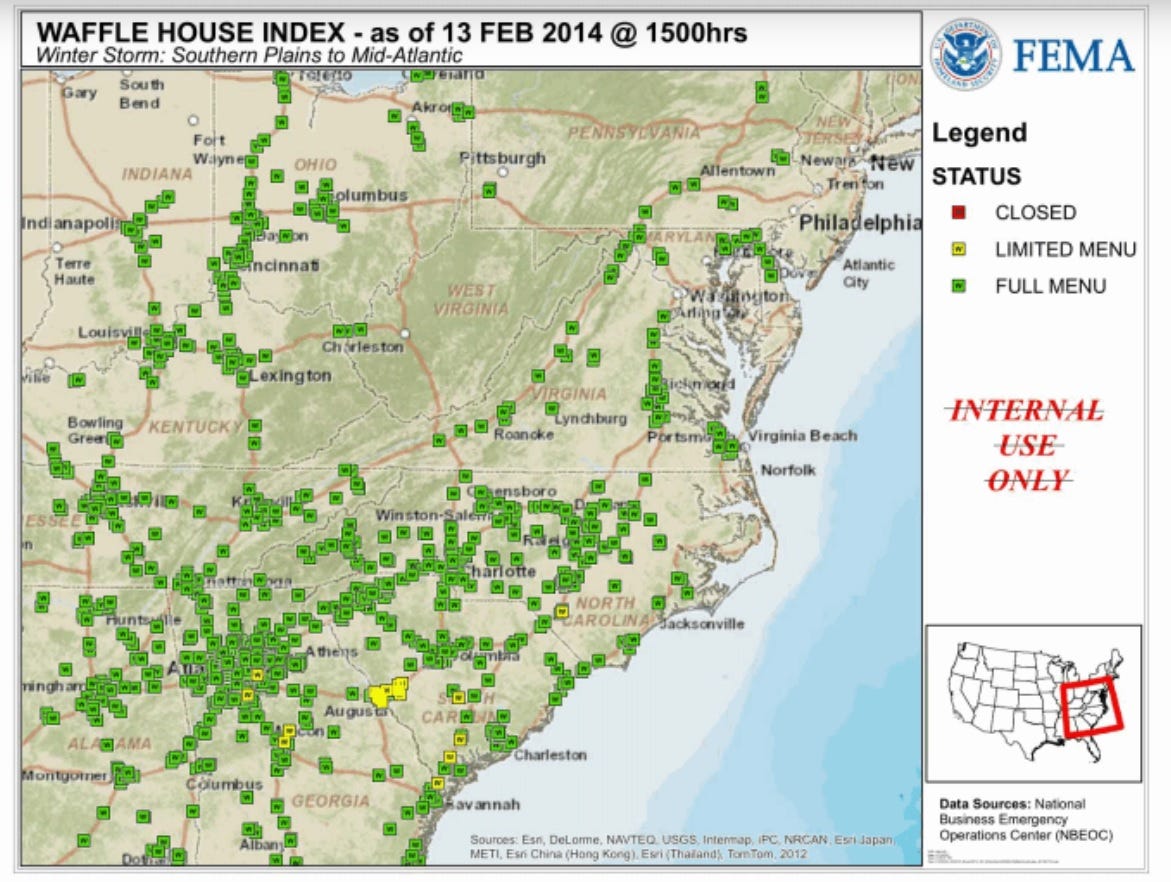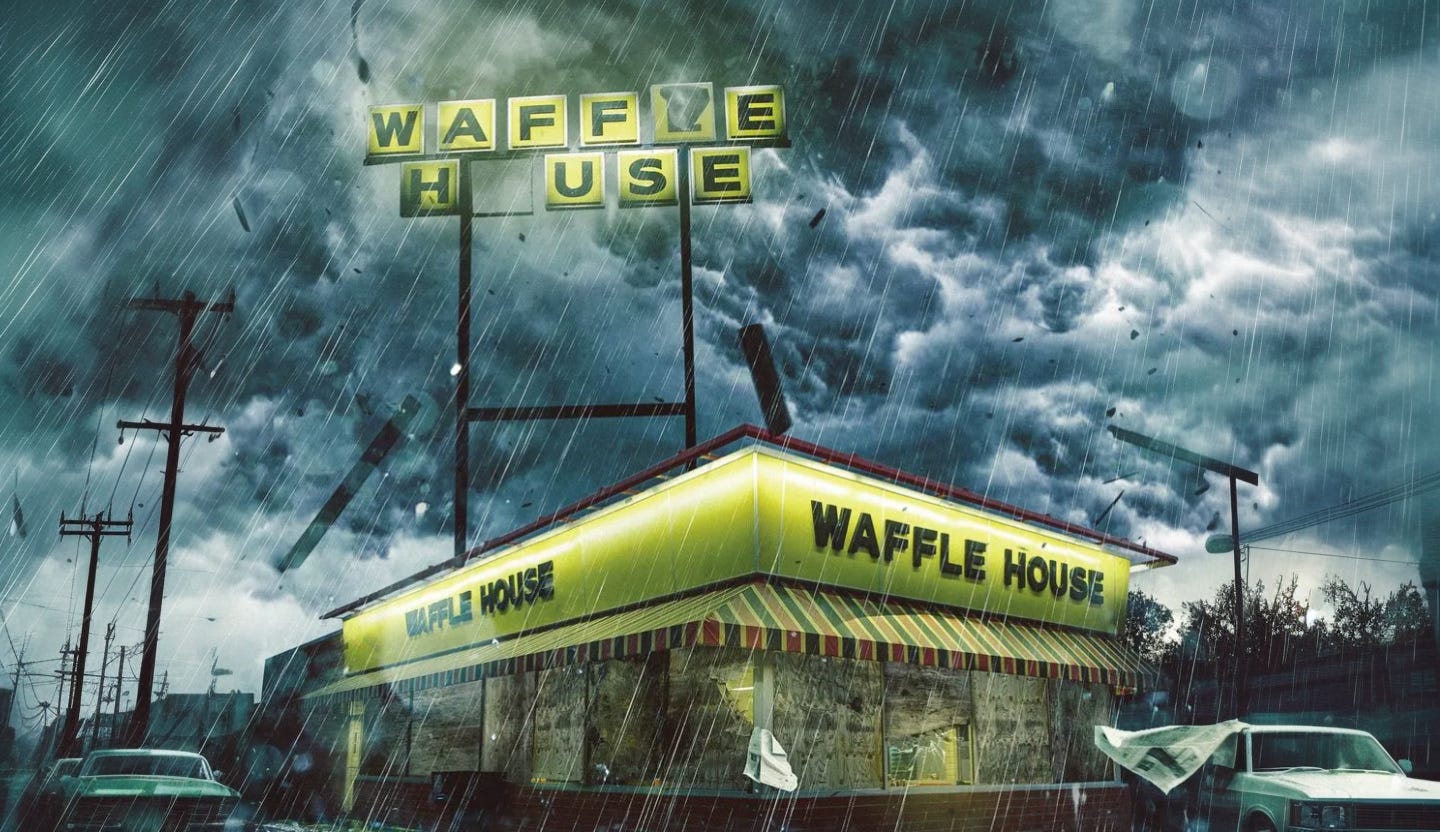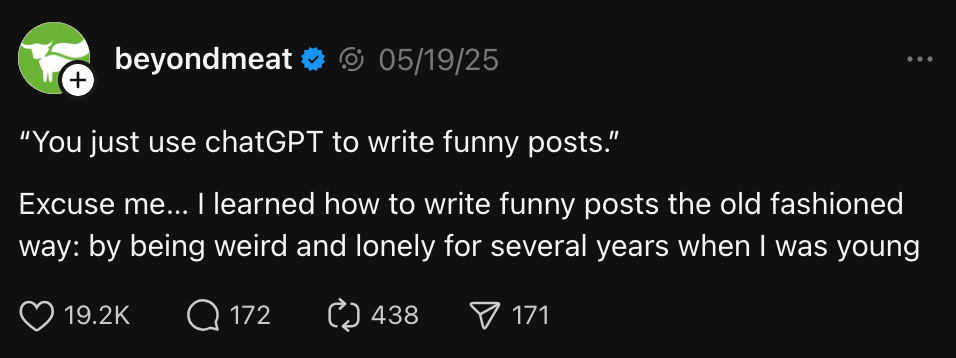Bad Idea #5: Waffle House as a disaster index
If Waffle House is closed, consider leaving town. If you still can.
That’s not a joke. It’s an actual emergency response metric used by FEMA during hurricanes, tornadoes, winter storms, and other natural disasters.
To repeat that for those in the back… the United States Government partners with Waffle House (a delicious diner chain) to help it decide how to allocate money and resources after weather disasters. It doesn’t sound real, but it’s true.
They call it the Waffle House Index, and it’s exactly what it sounds like.
BTW, if you’ve never experienced the culinary joy of a Waffle House menu, you have to do it at least once. I recommend getting your hashbrowns scattered and covered (crispy with cheese).
A key part of the Waffle House brand is they’re always open — 24 hours a day, 7 days a week — and they take that as a serious commitment.
If you manage to find a FedEx Office that’s open 24/7 these days, consider yourself lucky. But if you’re looking for a 24/7 diner, Waffle House is a sure thing.
Each dot on the above map is a Waffle House location. Green means open and fully operational. Yellow mean it’s running on limited-to-no power or water and serving a reduced menu. Red means it’s closed altogether, which almost never happens.
Waffle House has three limited menus that go into effect when there’s no power, no water, or (and this sounds especially terrible) no power AND no water.
Because of Waffle House’s mandate to always stay open, its data is useful if you’re a federal agency looking for neighborhoods most affected by an emergency.
Craig Fugate, FEMA Administrator 2009-2015, famously said:
“If Waffle House is closed, that’s not a good sign.”
Fugate first referenced what would become known as the “Waffle House Index” in 2011 after an F5 tornado hit Joplin, Missouri, highlighting it as an indicator of infrastructure and community recovery.
Imagine you're the head of FEMA, and one of your team members suggests Waffle House is a good reference point for how hard an area was impacted by a storm.
It doesn’t come across as a great idea at first. It sounds like the story behind how someone got fired.
The idea for the Waffle House Index came from FEMA’s field specialists noticing that Waffle House was only ever closed when a local emergency was especially bad. It’s a real resource still in use today.
When I spoke with Fugate about this for my book, he described the Waffle House Index as part of a shift inside FEMA at the time to “think beyond traditional disaster models” and not rely only on government data sources. He said this change in mindset of constantly asking “what if?” fostered “creativity, preparedness, and resilience.”
Waffle House’s system of tracking each store’s status is a proxy built from how bad things really are at a very local level.
This is the part that matters: one of the most effective metrics FEMA uses wasn’t designed as a metric. It was noticed. Named. Then adopted because it reflected something no model could show, how people behave when existing systems fall short.
It’s informal and scrappy.
So much of creativity is built on polishing an idea until it stops offending us. But many great ideas start with a strange hunch. An odd signal. Something that must be noticed through open exploration, not spreadsheets.
So what’s your Waffle House Index?
What unseen “this can’t possibly scale” signal is already telling you something your data missed? Not all useful research or data comes from a structured process. Look for new signals. Be curious.
Art/Social/Ad
New ideas are born from brushing up against life, a process I call happy collisions. Here are a few pieces of inspiration to keep the ideas flowing: one piece of ART, one SOCIAL post, and one AD (or a bit of clever marketing).
ART
Kathleen Ryan’s art is both gross and beautiful. Her giant rotting fruit sculptures scream mold and decay from afar, but close up, you can see beautiful, detailed work made from gemstones, beads, crystals, and sometimes old car parts.
SOCIAL
The most playful and inventive milk packaging design you’ve ever seen, designed by Vera Zvereva (for Russian brand Milgrad).
AD
Beyond Meat has clearly taken on the mantle of snarkiest “meat” product from Steak-umm.






